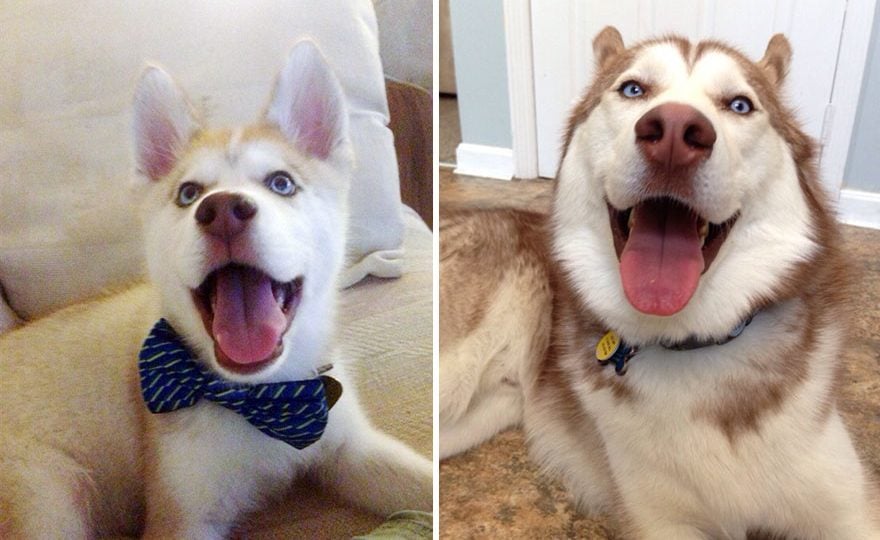Puppies grow up so fast. One day they’re falling asleep in your lap, and the next day they’re too big to fit! But when does a puppy stop being a puppy and become an adult dog? It goes without saying, but your puppy is unique! While puppy development follows a general timeline, don’t worry if your puppy doesn’t mature at the same rate as its littermates.
In general, puppies become adult dogs between one and two years of age. Other markers of a puppy becoming an adult include:
- Sexually maturity
- Physically full grown
- Emotionally maturity
- Responsive to training
- Other dogs view and respond to them as a fellow adult dog
Some puppies become dogs as early as one year old, and some dogs take up to two years to fully mature. If you’re not sure how old your dog is, ask your veterinarian.
But it’s not like they wake up the morning of their first birthday and are suddenly grown-up dogs! In fact, puppy maturation is a process, and it varies from dog to dog depending on size, breed, socialization, and more.
Sexual and physical maturity for dogs
Most dogs reach sexual maturity around six months old. Sexual maturity is the physical stage at which a dog can physically sire or give birth to puppies. Having puppies may sound very adult, but if you’ve ever spent time around a six-month-old puppy, you’ll know that they’re not fully grown up.
Similarly, a puppy can be physically mature before they’re fully adult. Physical maturity is when your puppy reaches their adult height, which depends on breed. In general, small breeds are fully grown around 12 months of age, while larger breeds can take between one to two years to finish growing.
In fact, if you’ve raised a puppy, you’ve probably experienced the frustration of having a physically mature pet that doesn’t quite know how to control their body.
“The zoomies” are a whole new experience when your puppy weighs 50 pounds.
Emotional maturity for dogs
Emotional maturity, on the other hand, is when a dog acts like a dog instead of a puppy. As with every other aspect of puppy development, the process of becoming emotionally mature takes place over time. You may not see it happening, but one day you’ll realize that your puppy has become a dog.
Emotional maturity coincides with your puppy’s hormonal surges evening out. As puppies grow and become sexually mature, they may act out, test boundaries, and “get in trouble.” But somewhere between one to one and a half years, your puppy will settle down, and their adult personality will emerge.
Puppies mature at their own rate, so it’s hard to identify the specific moment a puppy becomes an adult. As your puppy grows, watch them for these signs of emotional maturity:
- Listens and responds appropriately to training
- Settles down more readily
- “Listens” and responds to social cues from other dogs
Sometimes, the answer to the question “when is a puppy no longer a puppy” is simply, “when you can tell they’re an adult.” It depends on your particular puppy, and may take place over time.
When to switch from puppy food to dog food
Diet is one way to distinguish between the puppy and adult year. Puppy food has more calories than adult dog food because growing pups need more energy to fuel their day. As your puppy stops growing, you will eventually switch to dog food for adult dogs.
In general, you should start switching to adult-formula dog food when your puppy stops getting taller. The precise “when” depends on your dog’s size:
- Small breeds: 9-12 months
- Medium breeds: Around 12 months
- Large breeds: 12-16 months
But remember, just because your puppy has stopped growing physically doesn’t mean they’re fully mature emotionally and mentally.
How do you know a dog’s age?
If your dog came from a shelter, you may not know exactly when it was born. Wondering how to tell if your new puppy is actually a puppy?
Younger dogs tend to be more active and energetic. As they age, dogs slow down. But even an older adult dog can have puppy-like bursts of energy! The best way to know your dog’s age is to observe physical signs of aging.
Start by looking at their teeth. If your new pup has shiny white teeth that look a bit small for their jaw, they may be under 16 weeks of age. By the time they’re adults, dogs have full mouths of permanent teeth. Click here for more on how to age a dog by looking at their teeth.
Other physical signs of aging include:
- Graying around the muzzle
- Cloudy or pale eye color
- Lower energy or lameness
For dogs straddling the line between puppy- and adulthood, it can be hard to guess their precise age. You can always ask your veterinarian to assess your dog’s age.
Featured image: Bored Panda




